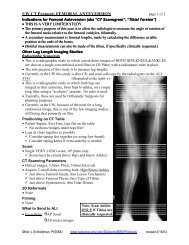Ankle and Foot 47 - Department of Radiology - University of ...
Ankle and Foot 47 - Department of Radiology - University of ...
Ankle and Foot 47 - Department of Radiology - University of ...
You also want an ePaper? Increase the reach of your titles
YUMPU automatically turns print PDFs into web optimized ePapers that Google loves.
A<br />
C<br />
B<br />
D<br />
<strong>47</strong> <strong>Ankle</strong> <strong>and</strong> <strong>Foot</strong> 2293 <strong>47</strong><br />
Figure <strong>47</strong>-96. Calcaneonavicular coalition seen<br />
radiographically in this 21-year-old who has been<br />
complaining <strong>of</strong> left ankle pain for at least 7 years. On<br />
physical examination, the subtalar range <strong>of</strong> motion <strong>of</strong> the<br />
left foot is half that <strong>of</strong> the asymptomatic right. A, Oblique<br />
radiograph <strong>of</strong> the asymptomatic right midfoot shows the<br />
normal relationship between the calcaneus (Ca) <strong>and</strong><br />
navicular (N), with no contact between them. B, Oblique<br />
radiograph <strong>of</strong> the symptomatic left foot shows the<br />
abnormal joint (arrowheads) between the calcaneus <strong>and</strong><br />
navicular. This is a nonosseous coalition. Lateral<br />
radiographs <strong>of</strong> the right (C) <strong>and</strong> left (D) ankles reveal<br />
elongated anterior processes <strong>of</strong> the calcaneus bilaterally<br />
(arrows). These bilateral “ant-eater” signs suggest that<br />
the patient has an asymptomatic calcaneonavicular<br />
coalition on the right that was not radiographically<br />
apparent on the oblique view (A).<br />
Talar beaks occur less frequently with nonosseous coalition<br />
because some subtalar motion remains.<br />
• Calcaneonavicular Coalition<br />
Of the two common locations for tarsal coalitions, calcaneonavicular<br />
coalitions can <strong>of</strong>ten be seen radiographically<br />
on the oblique view (Fig. <strong>47</strong>-96). Normally, the calcaneus<br />
<strong>and</strong> navicular do not touch (see Fig. <strong>47</strong>-96A); it is abnormal<br />
any time they get close enough to each other to form<br />
a joint (see Fig. <strong>47</strong>-96B), let alone a solid bony bridge.<br />
Another radiographic indication <strong>of</strong> a calcaneonavicular<br />
coalition is the presence <strong>of</strong> an elongated APC, sometimes<br />
called an ant-eater sign (Fig. <strong>47</strong>-96C <strong>and</strong> D). An elongated<br />
APC <strong>and</strong> an asymptomatic calcaneonavicular coalition<br />
may be seen as incidental findings on radiographs <strong>and</strong> CTs<br />
obtained for other reasons. And although an elongated<br />
APC may not cause a symptomatic coalition, it may be at<br />
increased risk <strong>of</strong> fracture (Fig. <strong>47</strong>-97).<br />
• Talocalcaneal Coalition<br />
Talocalcaneal coalitions, which occur across the middle<br />
facet <strong>of</strong> the subtalar joint, are difficult to demonstrate with<br />
conventional radiographs because these radiographs do not<br />
well pr<strong>of</strong>ile the middle facet. For this reason, coronal CT<br />
images obliqued to be perpendicular to the subtalar joint<br />
are the key imaging plane (Fig. <strong>47</strong>-95F). With osseous coalitions,<br />
solid bony ankylosis is present across the middle facet<br />
(see Fig. <strong>47</strong>-95F, white arrowheads). Nonosseous coalitions<br />
across the middle facet are not difficult to recognize by CT<br />
because they do not look like the flat, uniform middle facet<br />
we typically see on coronal oblique CT. In nonosseous<br />
coalitions, the articular surfaces are not smooth or congruous<br />
<strong>and</strong> tend to have an overgrown appearance (see Fig.<br />
<strong>47</strong>-95F, black arrowheads). An additional example <strong>of</strong> nonosseous<br />
middle facet coalition is shown in Figure <strong>47</strong>-98.<br />
• Tarsal Tunnel Syndrome<br />
The tarsal tunnel in the ankle is analogous to the carpal<br />
tunnel in the wrist. Both are spaces confined by the underlying<br />
bones <strong>and</strong> overlying fibrous ligaments through which<br />
pass tendons, blood vessels, <strong>and</strong> nerves. The ro<strong>of</strong> <strong>of</strong> the<br />
tarsal tunnel is the flexor retinaculum, a broad, fibrous<br />
b<strong>and</strong> extending between the medial malleolus <strong>and</strong> the<br />
medial tubercle <strong>of</strong> the calcaneus (Fig. <strong>47</strong>-99A). These retinacular<br />
fibers help prevent the medial tendons from<br />
becoming dislocated <strong>and</strong> can be identified on highresolution<br />
images (Fig. <strong>47</strong>-99B; see Fig. <strong>47</strong>-31). Because the<br />
tarsal tunnel is a relatively tight space, otherwise innocuous<br />
volume-occupying lesions, such as synovial cysts (Fig.<br />
Ch0<strong>47</strong>-A05375.indd 2293<br />
9/9/2008 5:35:50 PM
















